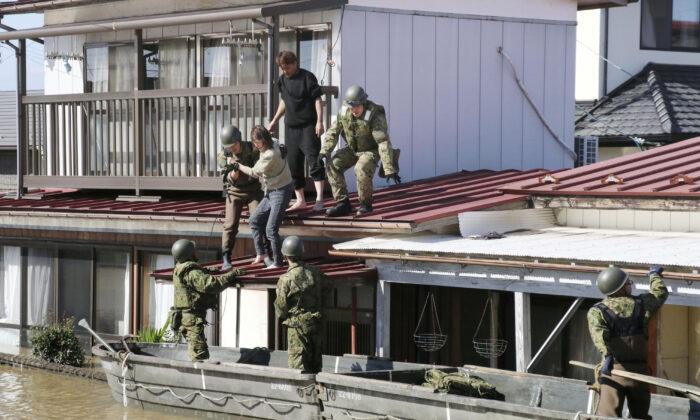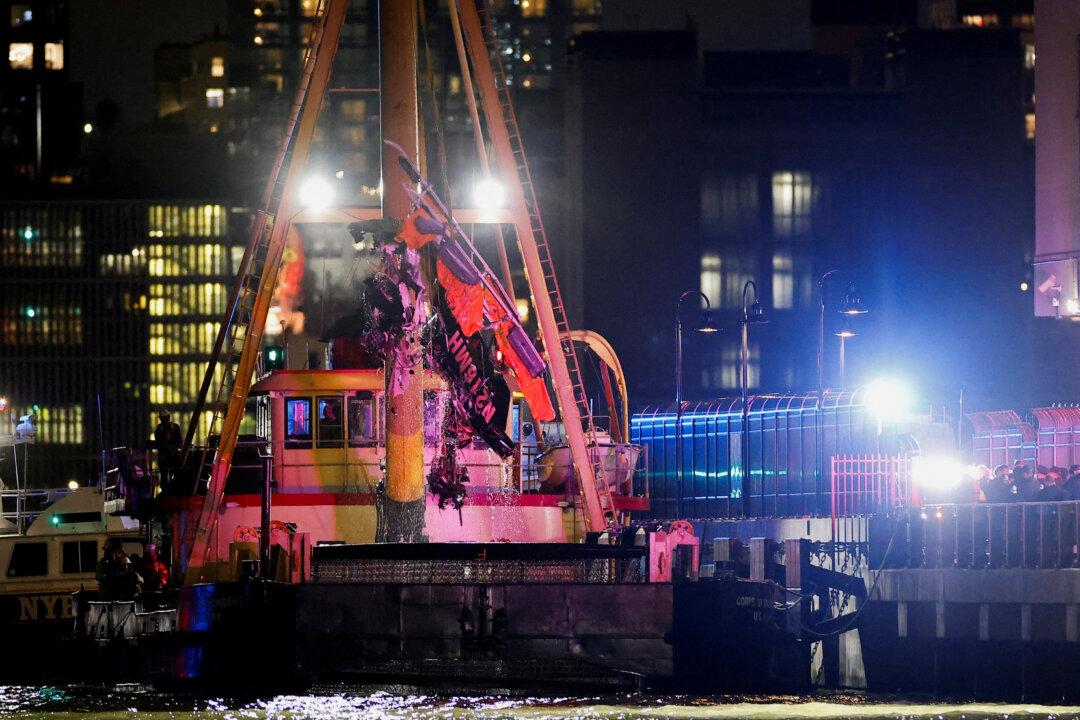NAGANO, Japan—Rescue workers in Japan waded through muddy, waist-high waters on Oct. 14 to search for missing people after one of the worst typhoons in recent history, as rain began falling again in some affected areas, stoking fears of further flooding.
Prime Minister Shinzo Abe said vast areas had been struck by the storm and called for urgent support to those affected.
At least 56 people were killed in the typhoon, which left vast sections of towns in central and eastern Japan underwater, with another 15 missing and 211 injured, public broadcaster NHK reported.
Tens of thousands of rescue workers and a fleet of helicopters fanned out in the affected areas, officials said.
“There still are many residents who have yet to be accounted for. Our people in uniform are working day and night in search and rescue operations,” Abe told an emergency meeting of ministers.
“Damage has been made in an extremely wide range of areas, and more than 30,000 people are still being forced to remain in the state of evacuation. It is our urgent task to offer meticulous support to those who have been affected.”
Typhoon Hagibis, which means “speed” in the Philippine language Tagalog, made landfall on Japan’s main island of Honshu on Oct. 12, before heading out to sea early on Oct. 13.
Groups of rescuers wearing goggles and snorkels looked for survivors while making their way in waist-high water in Nagano, central Japan, where the Chikuma River inundated swaths of land. A middle-aged man in Nagano, asked about the situation around his house, told NHK: “It’s just like a lake.”
Yoshinobu Tsuchiya, 69, returned on Oct. 14 to his home in Nagano city, near where the Chikuma had breached its banks, to find that his first floor had been flooded and that the garden he tended had turned to brown mud.
“So this is what it’s come to,” Tsuchiya told the Nikkei newspaper. “I can’t even imagine when we'll finish cleaning up. I’m sick of this flood.”
A neighbor in his 60s told the newspaper: “This is just like a tsunami. This is hopeless.”
At a second emergency meeting on Oct. 14, Abe urged ministers to do their utmost to help evacuees return to normal life as soon as possible.
More than 110,000 police officers, firefighters, soldiers, and coastguard personnel, as well as some 100 helicopters, were mobilized for Oct. 14’s rescue operations, Chief Cabinet Secretary Yoshihide Suga said.
Heavy rain was forecast for Oct. 14 in some parts of central and eastern Japan, where the soil is already loosened by record-breaking downpours from the typhoon, prompting Suga to urge residents to keep their guard up.
“Rain is expected in affected areas today. Because of the rain we have seen so far, levels of water are high in some rivers and soil is loose in some areas,” Suga said. “Please remain on your guard for landslides and river overflows.”
A Nagano city official said there were some showers by early afternoon, although they weren’t heavy.
Some parts of Japan saw about one-third of their average annual precipitation just over the weekend, causing 37 rivers to break their banks, NHK said.
More than 77,000 households were still without power by mid-afternoon on Oct. 14, a national holiday, the Ministry of Economy, Trade, and Industry said. That was down from 262,000 households as of midday a day earlier.
Also, about 136,000 households were without running water early on Oct. 14, Suga said.
In Fukushima, north of the capital, Tokyo Electric Power Co. reported nine cases of irregular readings from sensors monitoring water over the weekend at the Fukushima Daiichi nuclear power plant, which was crippled by a 2011 earthquake and tsunami.
But a Tokyo Electric official said on Oct. 14 that eight of the irregular readings were triggered by rainwater, and the other one by a malfunction of a monitor, and that there was no leakage of contaminated water.





